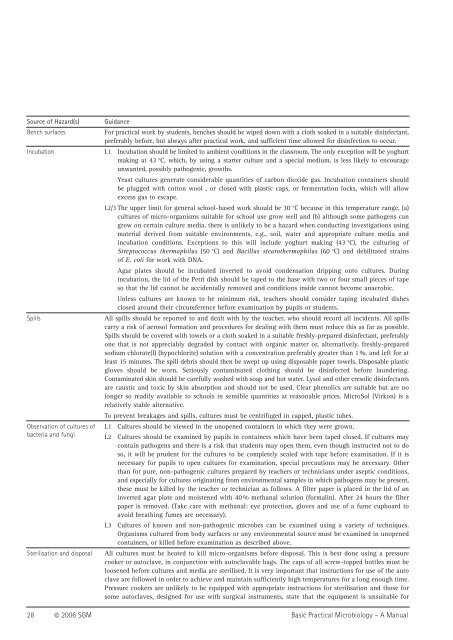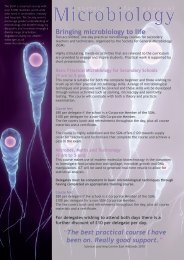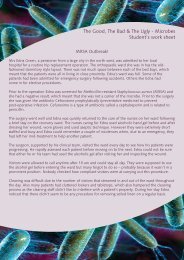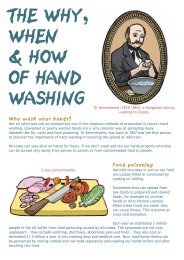Safety guidelines PDF - Microbiology Online
Safety guidelines PDF - Microbiology Online
Safety guidelines PDF - Microbiology Online
You also want an ePaper? Increase the reach of your titles
YUMPU automatically turns print PDFs into web optimized ePapers that Google loves.
Source of Hazard(s)GuidanceBench surfacesFor practical work by students, benches should be wiped down with a cloth soaked in a suitable disinfectant,preferably before, but always after practical work, and sufficient time allowed for disinfection to occur.Incubation L1 Incubation should be limited to ambient conditions in the classroom. The only exception will be yoghurtmaking at 43 °C, which, by using a starter culture and a special medium, is less likely to encourageunwanted, possibly pathogenic, growths.Yeast cultures generate considerable quantities of carbon dioxide gas. Incubation containers shouldbe plugged with cotton wool , or closed with plastic caps, or fermentation locks, which will allowexcess gas to escape.L2/3 The upper limit for general school-based work should be 30 °C because in this temperature range, (a)cultures of micro-organisms suitable for school use grow well and (b) although some pathogens cangrow on certain culture media, there is unlikely to be a hazard when conducting investigations usingmaterial derived from suitable environments, e.g., soil, water and appropriate culture media andincubation conditions. Exceptions to this will include yoghurt making (43 °C), the culturing ofStreptococcus thermophilus (50 °C) and Bacillus stearothermophilus (60 °C) and debilitated strainsof E. coli for work with DNA.Agar plates should be incubated inverted to avoid condensation dripping onto cultures. Duringincubation, the lid of the Petri dish should be taped to the base with two or four small pieces of tapeso that the lid cannot be accidentally removed and conditions inside cannot become anaerobic.Unless cultures are known to be minimum risk, teachers should consider taping incubated dishesclosed around their circumference before examination by pupils or students.SpillsAll spills should be reported to and dealt with by the teacher, who should record all incidents. All spillscarry a risk of aerosol formation and procedures for dealing with them must reduce this as far as possible.Spills should be covered with towels or a cloth soaked in a suitable freshly-prepared disinfectant, preferablyone that is not appreciably degraded by contact with organic matter or, alternatively, freshly-preparedsodium chlorate(I) (hypochlorite) solution with a concentration preferably greater than 1 %, and left for atleast 15 minutes. The spill debris should then be swept up using disposable paper towels. Disposable plasticgloves should be worn. Seriously contaminated clothing should be disinfected before laundering.Contaminated skin should be carefully washed with soap and hot water. Lysol and other cresolic disinfectantsare caustic and toxic by skin absorption and should not be used. Clear phenolics are suitable but are nolonger so readily available to schools in sensible quantities at reasonable prices. MicroSol (Virkon) is arelatively stable alternative.To prevent breakages and spills, cultures must be centrifuged in capped, plastic tubes.Observation of cultures of L1 Cultures should be viewed in the unopened containers in which they were grown.bacteria and fungi L2 Cultures should be examined by pupils in containers which have been taped closed. If cultures maycontain pathogens and there is a risk that students may open them, even though instructed not to doso, it will be prudent for the cultures to be completely sealed with tape before examination. If it isnecessary for pupils to open cultures for examination, special precautions may be necessary. Otherthan for pure, non-pathogenic cultures prepared by teachers or technicians under aseptic conditions,and especially for cultures originating from environmental samples in which pathogens may be present,these must be killed by the teacher or technician as follows. A filter paper is placed in the lid of aninverted agar plate and moistened with 40 % methanal solution (formalin). After 24 hours the filterpaper is removed. (Take care with methanal: eye protection, gloves and use of a fume cupboard toavoid breathing fumes are necessary).L3 Cultures of known and non-pathogenic microbes can be examined using a variety of techniques.Organisms cultured from body surfaces or any environmental source must be examined in unopenedcontainers, or killed before examination as described above.Sterilisation and disposal All cultures must be heated to kill micro-organisms before disposal. This is best done using a pressurecooker or autoclave, in conjunction with autoclavable bags. The caps of all screw-topped bottles must beloosened before cultures and media are sterilised. It is very important that instructions for use of the autoclave are followed in order to achieve and maintain sufficiently high temperatures for a long enough time.Pressure cookers are unlikely to be equipped with appropriate instructions for sterilisation and those forsome autoclaves, designed for use with surgical instruments, state that the equipment is unsuitable for28 © 2006 SGM Basic Practical <strong>Microbiology</strong> – A Manual









